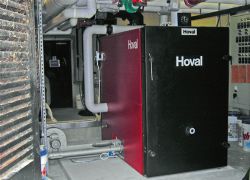Last year's changes to RHI biomass tariffs may result in a better spread of the incentive and focus minds on the key benefits of this renewable energy source. Adrian Walker explains
Following concerns expressed by the European Commission, the Department of Energy & Climate Change (DECC) announced last October that tariffs for biomass projects over 1MW would be reduced. Following parliamentary approval this has now been implemented with the large biomass tariff falling from 2.7p/kwh to 1p/kwh.
Unsurprisingly, the initial response within the industry was that this move would reduce the uptake of biomass heating and the potential environmental benefits would not be fully realised. However, I would suggest this move may result in higher numbers of smaller users taking up biomass heating, rather than the benefits of RHI being concentrated on large energy users, ultimately leading to a more
even spread of the RHI.
At the same time, this tariff change is unlikely to deter the use of biomass in larger projects. The most likely result is simply that the base loads for biomass will be less than 1MW. In fact, this is probably about right for most projects in the commercial sector as the predominant use of biomass is for meeting the base heating load through the year - or for domestic hot water when return temperatures are too high for condensing.

Positive about changes
Consequently, I feel very positive about these changes to the RHI tariffs and believe they will encourage better solutions based on sound engineering principles (i.e. using biomass for the right reasons), rather than simply addressing a need to tick a particular box.
Importantly, such systems will typically use a balanced mix of heat sources to take full advantage of the performance characteristics of each technology. As noted above, biomass will typically be used to meet base heat loads so there will be a need for another heat source to meet peak loads. Very often, the most energy-efficient way of doing this will include gas fired boilers, possibly supplemented by other heat sources such as solar thermal and heat pumps. In such cases, the configuration of the controls will play a key role in ensuring that each technology is used optimally.
Another important point to make is that the benefits of using biomass go far beyond the potential revenue from the RHI, though clearly such revenue is attractive and helps to accelerate the return on investment in biomass and other renewable heat sources.
Biomass heating also offers major benefits in its own right, not least of which is the near-carbon neutrality of biomass fuels. This is because the carbon emitted by burning biomass fuels was captured just a few years earlier when those plants were growing, maintaining the balance of the carbon cycle.
As a result, the carbon emissions associated with biomass fuels are largely restricted to the harvesting and transportation of the fuel. Sourcing biomass fuels from a local supplier helps to minimise these emissions and the better biomass fuel suppliers have already taken other carbon reduction measures to compensate for this and produce a 'close-to' carbon-neutral fuel. The carbon footprint of a project can be further reduced by using biomass boilers that have been manufactured in the UK.
It's also worth noting that the vast majority of the UK's sustainable wood pellet production is currently exported, so there is plenty of spare capacity to serve a growing UK biomass heat market with a secure fuel supply.
Another important point is that biomass boilers are relatively easy to retrofit to existing heating systems, as they deliver the same flow temperature (82°C) as traditional gas and oil boilers. This eliminates the need to replace heat emitters in the building to allow for lower flow temperatures, as can often be the case with other low carbon heating technologies.
Biomass can also play a key role in the centralised energy centres linked to district or community heating schemes that are increasing in popularity. In these projects, base heating loads through the year may be met by a CHP unit sized on its thermal output, supplemented by biomass heating to accommodate higher base loads in cold weather and gas-fired condensing boilers to respond to peak in heating demand. Here, the centralisation of plant in a dedicated energy centre makes it easier and more cost-effective to meet the storage requirements for the biomass fuels.
So rather than bemoaning the changes to the RHI and expecting the worst, it's clear there is still a strong market for biomass heating in the UK. Importantly, such projects will benefit from the skills of building services engineers and result in well-engineered systems that deliver maximum financial and environmental benefits.
// The author is managing director of Hoval //